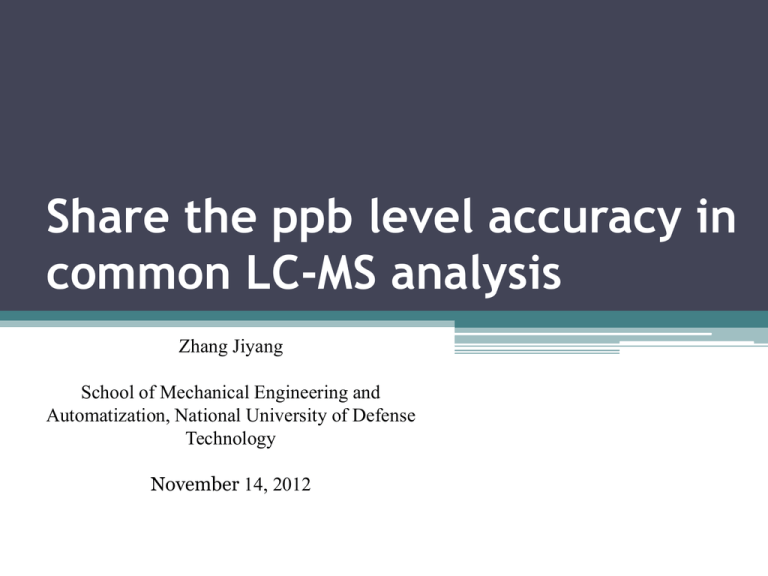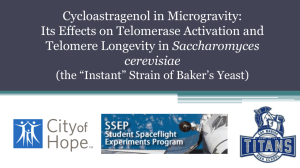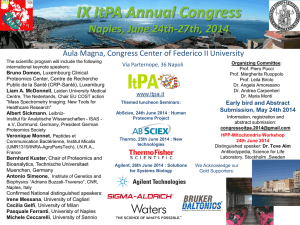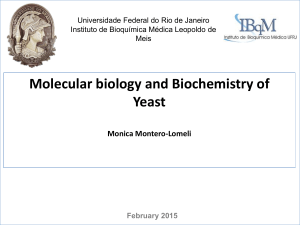
Share the ppb level accuracy in
common LC-MS analysis
Zhang Jiyang
School of Mechanical Engineering and
Automatization, National University of Defense
Technology
November 14, 2012
Outline
• Background
▫ Proteomics goes to the high-high age
▫ Instrument calibration and data re-calibration
• FTDR 2.0: implement ppb level re-calibration
▫ Workflow
▫ Algorithms
▫ Results
• Discussions
▫ How to utilize the high accuracy?
Background
Low-Low
High-Low
High-High
Proteomics: the discovery loop
Dreams
and
stories
Insights on
the
technologies
and biological
stories
Technology
needs
Proteomics
Data
analysis
algorithms
and tools
Advances on
instrument
and
experiment
protocol
High sensitivity LTQ
•Low-Low
MS and MS/MS
Very fast scan speed
MET: 3Da
No obvious isotopic profiles
MET: 0.6Da
Few isotopic profiles only for very high signals
LTQ/FT
Scan speed vs.
spectrum
quality
• High-Low
MS/MS scan
MS scan
Isotopic profile
Isotopic profile
(not so good)
LTQ/Orbitrap
Store and CID fragment
Ion storage
MS and MS/MS scan
Scan speed vs. spectrum quality
Isotopic profile
Isotopic profile
Some literatures
• Cox J, Mann M. Quantitative, high-resolution proteomics for data-driven systems biology.
Annu Rev Biochem. 2011 Jun 7;80:273-99.
• Mann M, Kelleher NL. Precision proteomics: the case for high resolution and high mass
accuracy. Proc Natl Acad Sci U S A. 2008 Nov 25;105(47): 18132-8.
• Nilsson T, Mann M, Aebersold R, Yates JR 3rd, Bairoch A, Bergeron JJ. Mass spectrometry in
high-throughput proteomics: ready for the big time. Nat Methods. 2010 Sep;7(9):681-5.
• Altelaar AF et al. Database independent proteomics analysis of the ostrich and
human proteome. Proc Natl Acad Sci U S A. 2012 Jan 10;109(2):407-12. Epub 2011 Dec 22.
• Lamond AI, Uhlen M, Horning S, et al. Advancing cell biology through proteomics in space and
time (PROSPECTS). Mol Cell Proteomics. 2012 Mar;11(3):O112.017731. Epub 2012 Feb 6.
More dreams with high accuracy and high resolution
instruments: Top-down, cross-link based PPI, PTM
identification and discovery, real time state monitor
of cells…
What can be benefited from high
accuracy?
•
•
•
•
Database search: less candidates
De Novo: less possible
XIC based quantification: less noise?
PTM: less false positives
blank
Yu L, Xiong YM, Polfer NC. Periodicity of monoisotopic mass isomers
and isobars in proteomics. Anal Chem. 2011 Oct 15;83(20):8019-23.
Mitra I, Nefedov AV, Brasier AR, Sadygov RG.
Improved mass defect model for theoretical tryptic peptides.
Anal Chem. 2012 Mar 20;84(6):3026-32.
Accuracy in control and common
experiments
Haas W, Faherty BK, Gerber SA, Elias JE, Beausoleil SA, Bakalarski
CE, Li X, Villén J, Gygi SP. Optimization and use of peptide mass
measurement accuracy in shotgun proteomics. Mol Cell Proteomics.
2006 Jul;5(7):1326-37.
<2ppm in well controlled experiments
Olsen JV, de Godoy LM, Li G, Macek B,
Mortensen P, Pesch R, Makarov A, Lange
O, Horning S, Mann M. Parts per million
mass accuracy on an Orbitrap mass
spectrometer via lock mass injection into
a C-trap. Mol Cell Proteomics.
2005;4(12):2010-21.
Instrument calibration
• Internal calibration and external calibration
Muddiman DC, Oberg AL. Statistical evaluation of internal and external mass
calibration laws utilized in fourier transform ion cyclotron resonance mass
spectrometry. Anal Chem. 2005 Apr 15;77(8):2406-14.
Regress a formula from frequency and charge space effect to m/z.
Instrument calibration
• Automatically performed on Orbitrap and FT
Parameters can be viewed in raw files
Data re-calibration
• Question: why the m/z measurement errors vary
with time?
• Question: Can we calibrate the m/z values after
the data collections?
If possible
• Which (parameters) are relative to the m/z
measurement errors?
Data re-calibration
Nat Biotechnol. 2008 Dec;26(12):1367-72.
MaxQuant enables high peptide identification rates,
individualized p.p.b.-range mass accuracies and
proteome-wide protein quantification.
Cox J, Mann M.
J Am Soc Mass Spectrom. 2009 Aug;20(8):1477-85.
Computational principles of determining and
improving mass precision and accuracy for
proteome measurements in an Orbitrap.
Cox J, Mann M.
J Proteome Res. 2011 Apr 1;10(4):1794-1805. Epub
2011 Feb 22.
Andromeda: A Peptide Search Engine
Integrated into the MaxQuant
Environment.
Cox J, Neuhauser N, Michalski A, Scheltema RA,
Olsen JV, Mann M.
Data re-calibration
•Our work:
J Proteome Res. 2009 Feb;8(2):849-59.
Mass measurement errors of Fourier-transform mass spectrometry (FTMS): distribution, recalibration, and
application.
Zhang J, Ma J, Dou L, Wu S, Qian X, Xie H, Zhu Y, He F.
•Simple Calibration
J Proteome Res. 2010 Jan;9(1):393-403.
MSQuant, an open source platform for mass spectrometry-based quantitative proteomics.
Mortensen P, Gouw JW, Olsen JV, Ong SE, Rigbolt KT, Bunkenborg J, Cox J, Foster LJ, Heck AJ, Blagoev B,
Andersen JS, Mann M.
•Nonlinear calibration:
Mol Cell Proteomics. 2010 Mar;9(3):486-96. Epub 2009 Dec 17.
DtaRefinery, a software tool for elimination of systematic errors from parent ion mass measurements in
tandem mass spectra data sets.
Petyuk VA, Mayampurath AM, Monroe ME, Polpitiya AD, Purvine SO, Anderson GA, Camp DG 2nd, Smith RD.
•Application: Search with large MET, filteration with little MET:
Comparison of Database Search Strategies for High Precursor Mass Accuracy MS/MS Data
Edward J. Hsieh, Michael R. Hoopmann, Brendan MacLean and Michael J. MacCoss
J. Proteome, 2010, 9 (2):1138–1143
FTDR: ppb level calibration
• Reduce the system error of m/z measurement,
share the ppb level accuracy in common LTQ/FT
and LTQ-Orbitrap experiments
Is it possible?
Workflow: Local to global
XIC (or EIC) : extracted ion chromatogram
Key Algorithms in FTDR
• Parameters extraction and selection
• XIC extraction
• Parent ion re-selection
• Local calibration models
Parameters for local model
• Basic: observed m/z , RT, TIC, parent ion
intensity (log transform), relative parent ion
intensity.
• Status: FT 83, Orbitrap:107,RF voltage,
temperature of ICR.
• Operation: Ion Injection time, Scan time et al.
• isotopic profile: goodness of fitting, number of
isotopic peaks.
How to obtain these parameters?
RT
m/z, intensity
Parameter selection
• Nonlinear relations: mRMR, minimum
Redundancy Maximum Relevance Feature
Selection
Chris Ding, and Hanchuan Peng .
Minimum redundancy feature selection from microarray gene expression data.
Journal of Bioinformatics and Computational Biology, 2005 , 3(2):185-205.
Recent works used this kind of method:
Reshef DN, et al. Detecting novel associations in
large data sets. Science. 2011 Dec
16;334(6062):1518-24.
Parametee selection
• FT:15
MI
0.6767
0.5389
0.0573
0.3203
0.2836
0.4637
0.0441
0.3682
0.2030
0.5298
0.0446
0.1401
0.3620
0.0567
0.0348
MI: Mutual information
Parameter
mz experiment
Retention time
FT IOS +275 Supply (V)
IsoNum
FT RF1 Amp. Temp. (C)
Ambient Temp. (C)
Remove the little MI
Gate Lens (V)
FT EA Temp. (C)
Nitrogen (%)
Source Current (uA)
FT EA -32 Supply (V)
RF Detector Temp (C)
RF Generator Temp (C)
Relative PInt
Front Section (V)
MI
0.6767
0.5389
0.3203
0.2836
0.4637
0.3682
0.2030
0.5298
0.1401
0.3620
Parameter
mz experiment
Retention time
IsoNum
FT RF1 Amp. Temp. (C)
Ambient Temp. (C)
FT EA Temp. (C)
Nitrogen (%)
Source Current (uA)
RF Detector Temp (C)
RF Generator Temp (C)
Parametee selection
• Orbitrap:15
MI
0.1792
0.0639
0.0512
0.0417
0.0393
0.0818
0.0362
0.0434
0.0329
0.0581
0.0304
0.0466
0.0392
0.0382
0.0286
Parameter
mz experiment
Abs PInt
-28V Supply Voltage (V)
FT IOS -275 Supply (V)
FT Deflector Measure Voltage (V)
IsoNum
MI>0.05
FT TMPC HS Temp. (°C)
FT Main RF Amplitude (Vp-p)
FT HV Lens 3 (V)
Relative PInt
Front Lens (V)
FT HV Ion Energy (V)
Gate Lens (V)
FT Storage Multipole Offset (V)
IsoMGD
m/z experiment
Retention time
Elapsed Scan Time
Relative PInt
IsoMGD
+24V Supply Voltage (V)
XIC Extraction
Isotopic profile match in each MS
(1) 4 kind of XIC trunked methods were used in FTDR :
1st –RT or count gap, 2nd RT range, 3rd MS signal count,
4th Savitzky–Golay (SG) smoothing and local
minimal points detection.
(2) The 1st is used in any XIC searching step in FTDR. The
2nd is only used in the calibration step and will be
automatically disabled when the 4th rules was used.
The 3rd is used to limited the volume of training
datasets by counting the observations.
Ie
N
gd
I I
e T
i 1
N
N
I I
i 1
2
e
i 1
2
T
I e : observedisotopicintensity
IT : predictedisotopicintensity
MET: m/z error tolerance
Parent ion re-selection
Incorrect position
Monoisotopic peak
overlap
E:\zhangjy\...\raw\B06-11071
2006-11-6 21:06:23
18_Mix
RT: 0.00 - 79.99
31.07
100
NL:
3.41E7
50.28
90
60
45.73
36.48
40
Relative Abundance
50
30
26.23
5.12 10.68 19.31 21.48
10
30.30
0
10
20
60
61.64
50
78.71
56.13
61.64
30
74.11
50
26.23
10 70
5.12 10.68 19.31 21.48
0
0
10
20
60
Time (min)
B06-11071 #771 RT: 12.97 AV: 1 NL: 1.33E1
T: ITMS + p NSI d w Full ms2 533.30@cid30.00 [135.00-1080.00]
433.75
100
68.35
30
40
50
60
74.11
70
Time (min)
B06-11071 #770 RT: 12.95 AV: 1 NL: 1.29E3
T: FTMS + p NSI Full ms [300.00-1600.00]
536.16626
Absent
70
60
50
424.75
218.17
30
631.33
365.33
729.33
1200
1000
800
Intensity
80
Relative Abundance
78.71
30.30
90
600
532.79095
496.83
20
10
65.77
56.13
20
40
45.73
36.48
40
68.35
30
55.04
40.45
70
65.77
0
40
TIC MS
B06-11071
80
20
All possible interpretations
18_Mix
31.07
100
55.04
40.45
70
2006-11-6 21:06:23
TIC MS
B06-11071
RT: 0.00 - 79.99
80
Relative Abundance
NL:
3.41E7
E:\zhangjy\...\raw\B06-11071
50.28
90
201.33
313.33
297.17
400
667.58
561.25
829.33
761.42
530.49158
895.75
538.16180
1026.33
200
0
200
300
400
500
600
m/z
Multiple possibility
700
800
0900
530
1000
531
532
533
534
535
m/z
536
537
538
539
50.10
22.91
50
86.40
Parent ion re-selection
0
0
20
E:\data_source\...\Raw\yeast_2_01
RT: 0.00 - 99.99
33.33
100
100
40
60
Time (min)
NL:
69.56 70.38
50.10 56.81
31.99
50
15.80 22.91
749.41
14.09
20
TIC M S
yeast_2_01
1362.97 1579.60
1852.61
86.40
0
7.31
Extract
all peaks
2.55E8
1137.55
15.05
40
2006-9-8 04:01:49
956.53
38.42
80
60
80
500
1000
1500
2000
m/z
0
0
20
40
60
Time (min)
80
Segment into different
isotopic profile group
852.14
100
852.48
E:\data_source\...\Raw\yeast_2_01
80
848.75
60
857.92
852.81
857.68
40
855.83
850.97
20
Relative Abundance
Relative Abundance
2.55E8
TIC M S
yeast_2_01
69.56
847.12
0
846
848
850
+2
C1
+
852
+
854
m/z
856
858
860
+2 C3
Decompose each isotopic profile group
33.33
100
31.99
38.42
50.10
NL:
2.55E8
TIC M S
yeast_2_01
69.56
22.91
50
86.40
0
0
Fitting to the predict distribution
+1
Assign back to the
C2
MS/MS spectrum
Relative Abundance
Relative Abundan
31.99
20
80
902.77
1133.87
100
50
40
60
Time (min)
571.27
800.40
1213.27
288.20
1517.79 1753.94
0
500
1000
m/z
1500
2000
Result: one MS/MS spectrum may generate multiple targets
Local models (try and implement)
• Linear model: parameter transform
• Local linear: multivariate(hard to implement)
• Local Linear:piecewise on RT
• Nonlinear:SVM regression (using
LIBSvm source code)
Robustness and Accuracy.
Result & discussion
• Local calibration and global calibration on
ISB_FT dataset
• Global calibration on the Yeast_FT_dataset
• Compare with MaxQuant
• Try on the label free quantification dataset
Performance comparison
Dataset: ISB_FT Mix 3, original MET 5ppm
Ref: Klimek J et al. The standard protein mix database: a diverse data set to assist in
the production of improved Peptide and protein identification software tools. J
Proteome Res. 2008 Jan;7(1):96-103.
Model types
Linear
Multivariate
Local regression SVM
Linear
MET(ppm)
2.46
2.13
2.19
1.56
0.8
0.6
1
0.6
0.5
0.5
0.8
0.6
0.7
0.4
0.3
Density
0.3
Density
Density
0.4
Density
res data
N(-0.0148,0.5275)
0.9
0.4
0.6
0.5
0.4
0.2
0.2
0.3
0.2
0.1
0.2
0.1
0
-5
0
dm (ppm)
5
0
-6
0.1
0
-4
-2
0
2
ppm
4
6
8
-4
-2
0
2
ppm
4
6
8
0
-10
Note: (1) not XIC global calibration,
(2) linear models: mz2, TIC*mz2tansform , SVM dose not use
(3) MET is estimated by the residual distribution.
-5
0
5
Data
10
Performance of Global Calibration
Re s ~ N (mu, sigma)
• Model:SVR
• MET:0.46ppm
MET 3sigma, mu 0
Signal intensity relative MET
is more reasonable!
2
m/z error vs sqrt(MS -Num)
Upper bound=mu+3*std(MS -Num)
1.5
Lower bound=mu-3*std(MS -Num)
1
0.5
2
0
-0.5
1.5
1
a=0.429970
b=0.058963
0.5
-1
-1.5
0
m/z error (ppm)
Normal: mu=-0;0099,sd=0.1536
2.5
Density
m/z error (ppm)
3
sigma a / MSNum b
2
4
6
12
10
8
sqrt(MS -Num)
14
16
18
0
-1.5
20
-1
-0.5
0
0.5
m/z error (ppm)
Breitwieser FP, et al. General statistical modeling of data from protein relative
expression isobaric tags. J Proteome Res. 2011 Jun 3;10(6):2758-66.
1
1.5
Database search results
Liu K, Zhang J, Wang J, Zhao L, Peng X, Jia
W, Ying W, Zhu Y, Xie H, He F, Qian X.
Relationship between Sample Loading
Amount and Peptides Identification and Its
Effect on Quantitative Proteomics. Anal Chem.
2009;81(4):1307-14.
• Dataset: Yeast_FT_RP10
• Search: Mascot V 2.1
Conclusion: The m/z error filtration can
affect the database search and result
validation model.
+/-1.3ppm, 15ppm,
Different for different mgf
Test
Submitted MS/MS spectrum
Total PSMs
Validated PSMs*
ppb level
MET min
MET max
Before calibration
15ppm
59828
45813
29400
2371
-4.321589
12.939775
After calibration
1.3ppm
91430#
47128
14299
14255
-1.011142
1.139910
After calibration
15ppm
91430#
58245
24071
23900
-1.099507
1.178323
After calibration
15ppm
91430#
58245
37225
36104
-3.2@
3.2@
# 91430: with parent ion re-selection, @ max range given by Intensity model
*Validate method: 2d cutoff model, FDR=1%, ref to: Ma J, et al. Proteomics. 2010;10(23):4293-300.
FTDR performance on 6 datasets
Datasets
D1
D2
D3
D4
D5
D6
B
A
B
A
B
A
B
A
B
A
B
A
Database
Search MET (ppm)
20
20
20
20
20
20
20
20
10
10
20
20
Validate m/z error
range
(ppm)
[-1.52, 5.09]
[-0.65, 0.63]
[-9.16, 2.15]
[-1.70, 1.59]
[-4.80, 17.82]
[-1.74, 1.72]
[-6.13, 6.08]
[-1.00, 0.93]
[-5.18, 8.78]
[-1.15, 1.20]
[-1.67, 8.89]
[-1.41, 1.49]
Validated
PSMs
10,783
10,507
5,980
6,817
16,715
27,182
19,758
34,008
14,290
35,126
44,382
53,017
ppb level
PSMs
3,277
10,507
478
6,264
560
24,492
8,325
34,008
4,525
33,283
1,974
50,534
Percent of ppb
level PSMs (%)
30.39
100.00
7.99
91.89
3.35
90.10
42.13
100.0
31.67
94.75
4.45
95.32
D1&D2: Klimek J et al. The Standard Protein Mix Database: A Diverse Data Set To Assist in the Production of Improved Peptide and
Protein Identification Software Tools. J. Proteome Res. 2008, 7 (1): 96-103.
D3: Chen M et al. Analysis of human liver proteome using replicate shotgun strategy. Proteomics, 2007. 7(14): 2479-88.
D4: Cox, J.; Mann, M., MaxQuant enables high peptide identification rates, individualized ppb-range mass accuracies and proteomewide protein quantification. Nature Biotechnology 2008, 26 (12):1367-1372.
D5: Jedrychowski M et al. Evaluation of HCD- and CID-type fragmentation within their respective detection platforms for murine
phosphoproteomics. Mol Cell Proteomics 2011, 10 (12):M111 009910.
D6: Liu K et al. Relationship between Sample Loading Amount and Peptide Identification and Its Effects on Quantitative Proteomics.
Anal. Chem. 2009, 81: 1307-1314.
Database search: Mascot 2.3
Different search engines
B
A
B
Mascot
A
B
X!Tandem
A
B
MassMatrix
A
Sequest
m/z error range (ppm)
Validate PSMs
[-1.45, 5.17]
[-0.68, 0.72]
[-1.52, 5.09]
[-0.65, 0.63]
[1.78, 5.48]
[-1.23, 1.04]
[-1.35, 4.88]
[-0. 61, 0.67]
11,581
11,625
10,783
10,507
8,299
8,188
6,492
8,224
Parameters: 2ppm, 0.6Da
Dataset: ISB_control_FT Mix 3
B: Before re-calibration
A: After re-calibration
ppb level PSMs (%) FDRAct (%)
31.18
100.00
30.39
100.00
37.06
98.24
32.10
100.00
0.61
0.57
0.49
0.40
1.04
0.66
0.92
0.73
In common experiments
• Dataset: Yeast total, 10 repeat LC-Runs
Liu K, Zhang J, Wang J, Zhao L, Peng X, Jia
W, Ying W, Zhu Y, Xie H, He F, Qian X.
Relationship between Sample Loading
Amount and Peptides Identification and Its
Effect on Quantitative Proteomics. Anal Chem.
2009;81(4):1307-14.
LC-Run
Original m/z
error mean
Original m/z
error std
Calibrated m/z
error mean
Calibrated m/z
error std
Total calibrated
MS2 spectrum
(Predicted*)
on ppb level
Yeast_FT_01
4.473023
3.086881
0.000000
0.352747
5145
2189
Yeast_FT_02
4.403325
3.051344
0.000000
0.357674
5237
2312
Yeast_FT_03
4.379363
3.033093
0.000000
0.347622
5283
2643
Yeast_FT_04
4.379597
2.991206
0.000000
0.350134
5387
2591
Yeast_FT_05
4.232066
2.900684
0.000000
0.352454
5347
2763
Yeast_FT_06
4.332880
2.946208
0.000000
0.334838
5322
2899
Yeast_FT_07
4.260813
2.879833
0.000000
0.346009
5301
2578
Yeast_FT_08
4.244320
2.855727
0.000000
0.352397
5358
2742
Yeast_FT_09
4.263944
2.858887
0.000000
0.329935
5427
2961
Yeast_FT_10
4.259115
2.801903
0.000000
0.367498
5412
1589
*The ppb level record is conservatively predicted by the signal intensity model.
Compare with MaxQuant
• Label free search on Yeast_FT_dataset
after calibration
mu=0.0297, sigma=0.5121
0.8
before
mu=3.956, sigma=1.5566
0.25
0.2
Density
Density
0.6
0.4
0.15
0.1
0.2
0.05
0
-5
0
mass error (ppm)
5
10
0
0
5
mass error (ppm)
10
15
20
*Dose not provide the m/z errors for the records after calibration.
Test
Submitted MS/MS spectrum
Total PSMs
Validated PSMs*
ppb level
MET min
MET max
After calibration
15ppm (FTDR)
91430
58245
37225
36104
-3.2@
3.2@
MaxQuant
63629
26982
21817
20037
-5.4939
10.4580
For label free dataset
• Dataset: Yeast total, 10 repeat LC-Runs
• Database search : X!Tandem Liu K, Zhang J, Wang J, Zhao L, Peng X, Jia W,
Ying W, Zhu Y, Xie H, He F, Qian X. Relationship
between Sample Loading Amount and Peptides
• Quantification: MassChroQ
Identification and Its Effect on Quantitative
Proteomics. Anal Chem. 2009;81(4):1307-14.
X: 0.4384
Y: 0.9505
1
before
after
0.9
Cumulative probability
0.8
0.7
0.6
B. Valot, O. Langella, E. Nano, and M. Zivy,
“Masschroq: A versatile tool for mass
spectrometry quantification,” Proteomics,
vol. 11, no. 17, pp. 3572–3577, 2011.
X: 0.153
Y: 0.5662
0.5
0.4
0.3
0.2
0.1
0
No obvious improvement on the CV
0
0.2
0.4
0.6
CV
0.8
1
1.2
• Smoothing and other filtration can reduce the
noise signal?
• The high resolution instrument provide the
“clean” signals?
E:\data_source\...\Raw\yeast_2_01
2006-9-8 04:01:49
RT: 59.16 - 73.95
63.34
63.48
NL: 2.93E5
63.25
250000
63.15
Base Peak m/z=
1195.535601196.73174 F: FTMS +
p NSI Full ms
[400.00-2000.00] MS
yeast_2_01
63.85
63.04
200000
64.05
62.94
64.18
150000
5
64.27
62.81
64.60
100000
71.26
68.82
3
65.02
66.36
50000
59.33
x 10
71.72
62.52
5ppm
10ppm
20ppm
30ppm
40ppm
50ppm
100ppm
500ppm
60.50
2.5
0
60
62
64
66
68
70
72
Time (min)
yeast_2_01 #6624-6811 RT: 62.69-64.99 AV: 100 NL: 1.07E5
F: FTMS + p NSI Full ms [400.00-2000.00]
1196.63595
100
2
90
Intensity
Intensity
XIC is robust to MET?
80
1196.13498
70
1197.13716
60
1.5
50
1
40
30
1197.63972
20
10
1195.16541 1195.95280
0
1195.0
1195.5
1196.0
1198.14109
1196.5
1197.0
m/z
1197.5
1198.0
1198.64736
0.5
1198.5
0
62
No preponderant signals in a large range
63
64
65
66
Time
67
68
69
70
Discussion
• Implement specific MET search for each spectrum?
Like Andromeda.
• Only can be tried on open source database search
engine: X!Tandem, Inspect and Crux.
• Initial result: no obvious difference on speed and
results for X!Tandem.
• Possible reasons: X!Tandem is so fast, and provide
less results than Sequest or Mascot.
Modified mgf
header
Modified source
code
Software design
• GUI
• Multiple
Threads
• Output:
mzXML,
mzML, or mgf
• Quick result
view
• Workspace
save and load
• Advance
parameters
Other applications under considering
• PTM search
• LC-MSE data processing
• Label free quantification with UPLC(narrow
XIC)?
Acknowledgement
•
•
•
•
•
ISB: control dataset
Dr. Jie Ma, BPRC
Prof. Yunping Zhu, BPRC
Prof. Xiaohong Qian, BPRC
Our team: Prof.Hong wei Xie, Wei Zhang,
Changming Xu.
Thank you for your attention!
E:\data\10FT-RAW\yeast_2_01
2006-9-8 4:01:49
RT: 0.00 - 100.00
100
15.71
10.57
0
100
22.91 32.98 43.24 50.10
22.88
15.84
68.78
42.00 43.26 50.12
69.91
1.02
0
100
15.70
2.79
0
100
22.68 32.98 43.24 50.13
53.88
16.47
10.80
0
100
15.59
69.33
22.61 32.84 43.09 49.92
56.71
69.72
22.54 32.84 43.22 49.96
57.20
70.00
0.24
0
100
15.36 21.92 32.51 42.76 49.68
13.56
0
100
42.82 49.85
15.34 21.84 32.45
13.71
0
100
15.08 21.76
13.89
0
0
20
NL: 5.25E7
Base Peak F: FTMS + p NSI Full ms
83.83 85.16 [400.00-2000.00] MS yeast_2_01
NL: 6.20E7
Base Peak F: FTMS + p NSI Full ms
81.02
85.92 [400.00-2000.00] MS yeast_2_02
80.81 85.76
NL: 5.36E7
Base Peak F: FTMS + p NSI Full ms
80.88
85.73 [400.00-2000.00] MS yeast_2_04
NL: 5.67E7
Base Peak F: FTMS + p NSI Full ms
[400.00-2000.00] MS yeast_2_05
85.68
56.43 69.77
80.88
32.47 42.72
49.79
40
60
Time (min)
NL: 5.27E7
Base Peak F: FTMS + p NSI Full ms
86.16 [400.00-2000.00] MS yeast_2_06
56.56 69.95
80.81 88.20
56.58
NL: 5.64E7
Base Peak F: FTMS + p NSI Full ms
[400.00-2000.00] MS yeast_2_03
70.04
85.81
80
NL: 5.61E7
Base Peak F: FTMS + p NSI Full ms
[400.00-2000.00] MS yeast_2_07
NL: 6.16E7
Base Peak F: FTMS + p NSI Full ms
[400.00-2000.00] MS yeast_2_08









